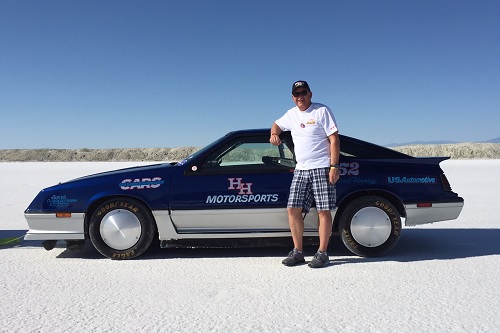Stillwell with his school car on the Bonneville Salt Flats
In northwestern Utah sits a vast, barren, bright white expanse of land, known as the Bonneville Salt Flats.
The giant salt pan, where visitors are said to be able to see the curvature of the Earth as the sun rises, is among the longest flat stretches of land found in the world, and has been used for decades by drivers in search of serious speed.
This week, Geoff Stillwell, the founder of Maidstone-based
Beech Underwriting Agencies, will be attempting to break a world record for land speed in his class of car, which currently stands at 212 miles per hour.
Stillwell’s car, custom-made for the feat, is currently being towed 2,000 miles from Tennessee, where it is kept, to the Bonneville Speedway where its driver awaits, hoping to make history.
“When we were there are a few weeks ago it was 95 degrees Fahrenheit in the shade, in the sun you’re looking at 135 degrees Farenheit,” Stillwell told
Insurance Business.
“It’s compulsory to wear hats and sunglasses, because you have the equivalent of snow blindness – because the salt is so bright, it reflects the light. The lighting there is amazing. It’s one of those places on the planet where nothing lives – there’s not a bug, not a fly, not a worm, there is nothing,” he said.
So dry is the terrain that it can suck the moisture out of you, says Stillwell. “You have to make sure that you keep hydrated with proper salt and sugar, not the caffeine energy drinks. I use the sport drinks to keep myself hydrated with all the electrolytes. If you don’t, you can become very ill, very quickly.”
This week’s attempt will be Stillwell’s third. An attempt last month was derailed by an oil leak that took days for his team to find, and was eventually narrowed down to an engine seal that was two-thousandths of an inch too small.
The preparation is mostly scientific, rather than physical, explains Stillwell.
“There are various calculations which tell you more or less what you have to generate in terms of horsepower to make you achieve a certain speed,” he said. “And there are a number of other mathematical equations so that you know if your engine is producing X amount of horsepower, you then work it backwards to the diameter of the wheels, how fast they are rotating, how far they rotate.”
The journey to this point has been several years long, and has seen Stillwell achieve various licences, increasing in speed each time.
“You can’t just turn up and drive. They are very strict, because you do something wrong out there and it can have an enormous impact on everything around you. So they’re very, very strict on making sure that you actually know what you’re doing,” he said.
Ahead of his attempt, Stillwell has high hopes and a clear mind.
“The first thing I do when we get the car out there is get back in the car, and refamiliarise myself with it. I put my fire suit on, my helmet, and sit in the car, shut my eyes down,” he explained.
“You have to be very respectful of the car, and you have to be very respectful of the salt, because you can do something stupid. You have to be able to say – I need to take my foot off the throttle. And you mustn’t do anything erratic – if you’re erratic you’re going to have a problem. You have to do everything smoothly, and that way you can be safe,” he said.
“It is an absolutely amazing place to be, it’s incredible. And it’s a very humbling place to be.”
Related stories:
How do you insure a madcap 3,000-mile super rally across 10 countries?
London Bridge attack victims CAN make successful claims without ‘terrorism’ tag


